The Texas Instruments Compact Computer 40
and Compact Computer 40+
The TI CC-40 is a cross between a high powered calculator and a laptop
computer. It comes with 6K to18K of RAM onboard and a 16K cartridge which
boosts the available RAM to as much as 34K. It makes a great note taking
machine or slap in a math cartridge and you've got a monster of a statistics
calculator. Pull that cartridge out and throw in another one and you've
got a nifty p-code computer.
The main problem with this little unit is the storage system. TI
attempted to bridge the gap between cassette storage and disk drives with what
was generally referred to as a stringy floppy, in essence a very high speed endless loop
cassette. TI's brand name for this was a Wafertape. Unfortunately, there
were some critical timing problems with start ups and stops such that a tape
written on one unit can not be read by another tape drive. Sometimes the
tape couldn't even be read by the same drive that had formatted it! TI decided to
re-engineer the CC-40 and add a cassette port. The new unit was to be
called the CC-40+. It was going to be introduced about the same time TI
canceled the 99-4/A.
TI also decided to attempt to build a floppy drive device for the hexbus.
It never made it into full production and rumors have it that only 6 are know to
exist on the whole planet. I've managed to acquire one of these.
Check here for a full pictorial!
I had bought a CC-40 back when they were new, a 6K unit. When I
heard about the upgrade from 6K to 18K, I contacted TI about having this done.
I was told by an engineer on the CC-40 project about the demise of the CC-40
along with the 4A, but he would be willing to upgrade my machine for me at no
charge. I jumped at the offer. When I got my little buddy back I noticed
an extra port on the back. When I asked about it, he told me that what I
now had was the CC-40+. Yep I got a prototype with the standard cassette
port. He also made a deal with me for several pieces of software and
hardware that weren't released to the public. Unfortunately, I got hard up
for money not long after picking up most of what he offered and had to sell it.
That was one of the dumber things I've ever done!
Well, I finally got hold of another 40+. This particular unit isn't
quite as polished as the first 40+ I had. This is an engineering
sample. Still, it works the same as the other did, so I'm not extremely
unhappy. Still should've held onto the first one tho. Especially
considering I also had a 5.25" floppy unit, a video interface and a
editor/assembler cartridge.
After some email exchanges with a former member of the CC-40 team, I found out some
more interesting facts. Seems the 40+ was just a sort of a stop-gap.
There were plans for a CC-70 which would have included 4 cartridge ports, more
RAM, and an 8 X 80 character display with graphics capability. Supposedly
all that came out of it were some hardware simulators with 99% of the software
completed. Unfortunately, the first batch of custom gate arrays were
flawed and the 99/4A was canceled about the same time, so none were actually
built. Too bad, it sounds like it would've been a sweet machine!
TI did eventually revisit this concept and introduced the TI-74 BASICALC and
TI-95 PROCALC. Both of these utilize a dockbus, which, while physically
different, is electrically the same bus with the addition of a couple of voltage
pins. TI also introduced a PC-Interface for the dockbus. I am
currently building an adapter for the PC-IF to the hexbus as an alternative storage
medium for the CC-40 and 40+. It's been done by several people, so I know
it can be done. Just need to find some time!
There is also an update for the PCIF program for newer computers.
This is being developed by Peter Engels in Germany. His version works
exactly the same as the original PCIF program, but has an adaptable delay to
allow for the greater time differences between the CC-40 and newer
computers. He's also developed a version for OS/2 users. If you'd
like to get a copy, try here.
Here's what the basic CC-40 system looks like.
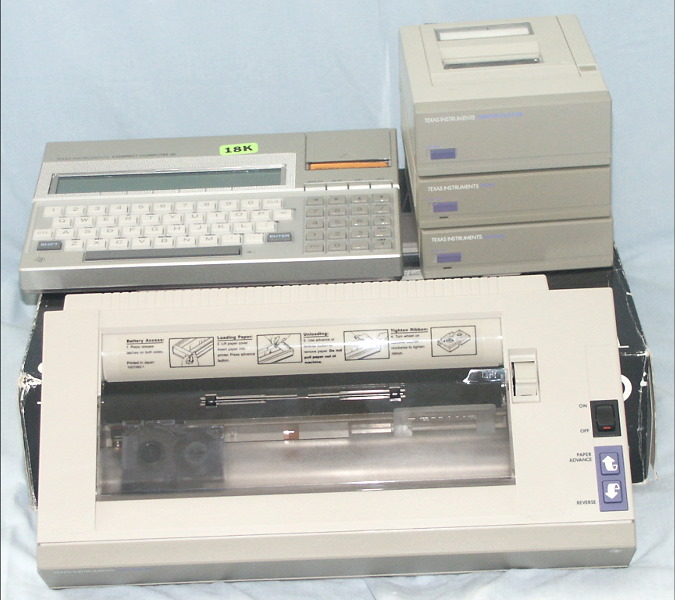
My full system showing the CC-40, Printer 80, hexbus floppy drive, and the hexbus stacked
peripherals. |
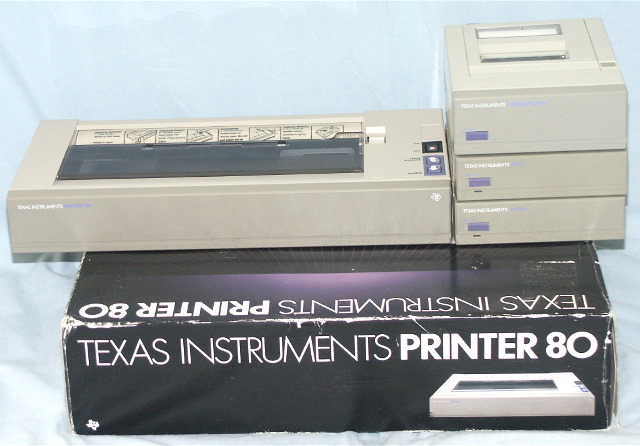
The "stack." Top to bottom are:
1. 4-pen printer plotter,
2. RS-232/parallel interface, and
3. 300 baud modem. To the left is the Printer 80 80 column thermal
transfer printer. |
Several people have asked me to show the differences between the 40 and
the 40+, so I whipped out my trusty Minolta Dimage 7 digital camera and here you
go.

They don't look a whole lot different do they? The unit on the
left is the 40+. |

Looking at the bottom, you can see the "Notice" on the 40+
designating it as a engineering sample. |

Yup! That's what it is! |
 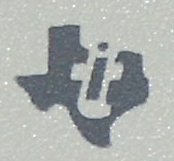
The logo on the left is from the 40 and the logo on the right is from
the 40+. |

Here's where things get interesting! Notice the extra port on
the unit on the left? Yes, that's a cassette port. This is
the major difference between the 2 units. |
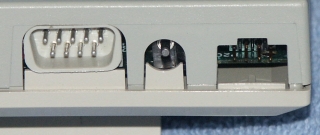 
40+ on the left, 40 on the right. Quite obvious there's
something going on here. |

With the back cover off. It's like the motherboard for
the 40+ is essentially turned upside-down. Notice the clump of
resistors on the top right of the 40. These are bleeder/pulldown
resistors for the
hexbus. Good idea to have something like that when dealing with
CMOS devices. Looks like the TI engineers forgot about that! |

Here's the other side of the 40+ motherboard. Notice there
isn't that clump of resistors around the hexbus connector for bleeding
off transients. They actually have a place on the motherboard!
Another big difference is the satellite board to the right of the
motherboard. |
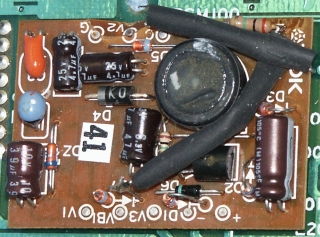
I had a couple of people email me saying this is probably the
cassette interface. From what I can tell, that's a
reasonable assumption. |
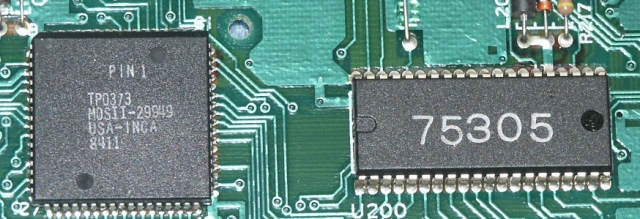
This is the cpu and ROM from the 40+. 75305? Some variant
of the 70C20? Yep.
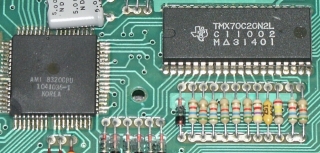
ROM and cpu from the 40. |

The notice stamped onto the back of the 40+. |
 
Here's another big difference between the 40+ and the 40. The
pins on the left are from the 40+. They connect the motherboard
with the keyboard and display circuitry. The ribbon cable on the
right is from the 40. |
I was just recently given a late prototype of the CC-40. Here's
some shots and comments.
Return
to McCain's Museum of Ancient Personal Computing
Back to front page

















